Chairman of the National Assembly of Vietnam
| Chairperson of the National Assembly Chủ tịch Quốc hội | |
|---|---|
|
| |
| Appointer | Deputies of the National Assembly |
| Term length |
Five years renewable |
| Inaugural holder | Nguyễn Văn Tố |
| Formation | 2 March 1946 |
The Chairman of the National Assembly of Vietnam (Vietnamese: Chủ tịch Quốc hội Việt Nam), formerly the Chairman of the Standing Committee of the National Assembly of Vietnam (Chủ tịch Ủy ban Thường vụ Quốc hội Việt Nam) from 1946 to 1981, is the legislative speaker of the Vietnamese parliament, the National Assembly. The parliament is, in the words of the constitution, "the highest representative organ of the people; the highest organ of state power ... , the sole organ that has constitutional and legislative rights".[1]
The chairman is elected by the deputies (members) of the National Assembly in the first season of the assembly's tenure. The Standing Committee, of which the chairman is a member, is a permanent body which controls the activities of the National Assembly when it is not in session. The chairman and the other members of the Standing Committee have to resign from their posts when the National Assembly dissolves itself, which it normally does every fifth year.[2] The chairman presides over the sessions of the National Assembly and authenticates laws and resolutions passed by the National Assembly by signing them. The chairman leads the activities of the Standing Committee and organises its external relations with other state bodies and is responsible for maintaining cordial relations between the members of the Standing Committee.[3] The deputies of the National Assembly have the right to question the chairman.[4]
The powers and prestige of the office of chairman has varied throughout the years. For instance, the two first officeholders Nguyễn Văn Tố and Bùi Bằng Đoàn were not members of the Communist Party, while Trường Chinh, the fourth chairman, was ranked second in the Politburo hierarchy. Still, of the ten people who have chaired the National Assembly, five of them have been members of the Politburo. The current chairman is Nguyễn Thị Kim Ngân,[5] and she is ranked third in the Politburo hierarchy.[note 1]
History
The first chairman of the Standing Committee of the National Assembly was the scholar Nguyễn Văn Tố; he was not a member of the Communist Party. On 3 March 1946, under the chairmanship of Nguyễn Văn Tố, the National Assembly formed the first government of the Democratic Republic of Vietnam.[6] Nguyễn Văn Tố was succeeded in office on 9 November 1946 by Bùi Bằng Đoàn, a poet and another non-Communist Party member. While he was never a member of the Communist Party, he was a committed revolutionary.[7] Tôn Đức Thắng succeeded Bùi Bằng Đoàn as chairman in 1955, and was the first chairman to be a member of the Communist Party.[8] Trường Chinh became the fourth and longest-serving chairman of the National Assembly in Vietnamese history, holding the post from 1960 to 1981, when he became chairman of the State Council, a newly established post.[9] Nguyễn Hữu Thọ, a Southerner, succeeded Trường in 1981, as chairman, but he was not a member of the Politburo. Nguyễn Hữu Thọ stepped down as chairman in 1987, and was succeeded by Lê Quang Đạo, another non-Politburo member. As with Nguyễn Hữu Thọ, Lê Quang Đạo's tenure lasted one term.[10] Nông Đức Mạnh was elected chairman in 1992, and held office until 2001 Nông was the first chairman who came from a minority background, the Tày, and was the first chairman since Trường who was a Politburo member.[11] Nông stepped down in 2001, and was succeeded by Nguyễn Văn An, who served as chairman from 2001 until 2006.[12] On 26 June 2006 Nguyễn Phú Trọng was elected chairman with a majority of 84.58% of the National Assembly deputies in favour.[13] Nguyễn Phú Trọng stepped down in 2011 because of his election to the post of General Secretary of the Central Committee of the Communist Party of Vietnam,[14] and was succeeded by Nguyễn Sinh Hùng. Nguyễn Sinh Hùng stepped down on 31 March 2016, and was replaced by Nguyễn Thị Kim Ngân.[15] She's the first women to hold the office.[15]
Officeholders
| No. [note 2] |
Rank [note 3] |
Name (birth–death) |
Portrait | Took office | Left office | National Assembly |
|---|---|---|---|---|---|---|
| 1 | — | Nguyễn Văn Tố (1889–1947) |
 |
2 March 1946 | 8 November 1946 | 1st convocation (1946–60) |
| 2 | — | Bùi Bằng Đoàn (1889–1955) |
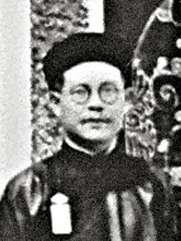 |
9 November 1946 | 13 April 1955 | |
| 3 | — | Tôn Đức Thắng (1888–1980) |
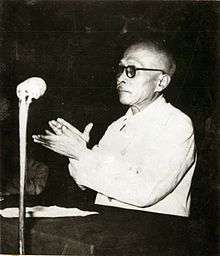 |
20 September 1955 | 15 July 1960 | |
| 4 | 4 | Trường Chinh (1907–88) |
 |
15 July 1960 | 4 July 1981 | 2nd convocation (1960–64) |
| 3rd convocation (1964–71) | ||||||
| 4th convocation (1971–75) | ||||||
| 5th convocation (1975–76) | ||||||
| 2 | 6th convocation (1976–81) | |||||
| 5 | — | Nguyễn Hữu Thọ (1910–96) |
 |
4 July 1981 | 18 June 1987 | 7th convocation (1981–87) |
| 6 | — | Lê Quang Đạo (1921–99) |
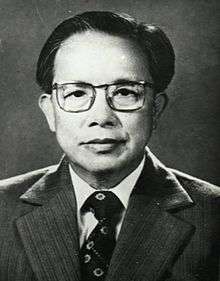 |
18 June 1987 | 23 September 1992 | 8th convocation (1987–92) |
| 7 | 10 | Nông Đức Mạnh (1940–present) |
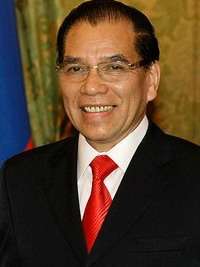 |
23 September 1992 | 27 June 2001 | 9th convocation (1992–97) |
| 4 | 10th convocation (1997–2002) | |||||
| 8 | 12 | Nguyễn Văn An (1937–present) |
 |
27 June 2001 | 26 June 2006 | 11th convocation (2002–07) |
| 9 | 7 | Nguyễn Phú Trọng (1944–present) |
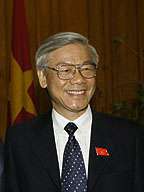 |
26 June 2006 | 23 July 2011 | |
| 6 | 12th convocation (2007–11) | |||||
| 10 | 4 | Nguyễn Sinh Hùng (1946–present) |
 |
23 July 2011 | 30 March 2016 | 13th convocation (2011–16) |
| 11 | 3 | Nguyễn Thị Kim Ngân (1954–present) |
 |
31 March 2016 | Incumbent | |
| 14th convocation (2016–21) | ||||||
Notes
- 1.^ The Politburo of the Central Committee is the highest decision-making body of the CPV and the Central Government. The membership composition, and the order of rank of the individual Politburo members is decided in an election within the newly formed Central Committee in the aftermath of a Party Congress.[16] The Central Committee can overrule the Politburo, but that does not happen often.[17]
- 2.^ These numbers are not official.
- 3.^ The Central Committee when it convenes for its first session after being elected by a National Party Congress elects the Politburo.[16] According to David Koh, in interviews with several high-standing Vietnamese officials, the Politburo ranking is based upon the number of approval votes by the Central Committee. Lê Hồng Anh, the Minister of Public Security, was ranked 2nd in the 10th Politburo because he received the second-highest number of approval votes. Another example being Tô Huy Rứa of the 10th Politburo, he was ranked lowest because he received the lowest approval vote of the 10th Central Committee when he standing for election for a seat in the Politburo. This system was implemented at the 1st plenum of the 10th Central Committee.[18] The Politburo ranking functioned as an official order of precedence before the 10th Party Congress, and some believe it still does.[16]
References
General
The number of chairmen of the National Assembly, their names, and when they took and left office, was taken from this source:
- Staff writer. "Tìm hiểu về Bầu cử đại biểu QH và HĐND qua các thời kỳ" [Learn about the Election of Deputies to the National Assembly and People's Councils at different times] (in Vietnamese). Medical College of Quảng Ninh. Retrieved 15 September 2012.
Specific
- ↑ "Preamble of the Constitution of the Socialist Republic of Vietnam". Government of the Socialist Republic of Vietnam. Retrieved 16 June 2012.
- ↑ "Political system". Government of the Socialist Republic of Vietnam. Retrieved 16 June 2012.
- ↑ "Article 92 of the Constitution of the Socialist Republic of Vietnam". Government of the Socialist Republic of Vietnam. Retrieved 16 June 2012.
- ↑ "Article 98 of the Constitution of the Socialist Republic of Vietnam". Government of the Socialist Republic of Vietnam. Retrieved 16 June 2012.
- ↑ "Vietnam appoints new legislative chairperson". Tuoi Tre News. 31 March 2016.
- ↑ Hoang 2008, p. 517.
- ↑ Staff writer. "Bùi Bằng Đoàn" (in Vietnamese). National Assembly of Vietnam. Retrieved 14 July 2012.
- ↑ Staff writer. "Danh sách Uỷ viên Uỷ ban Thường vụ Quốc hội Khoá" [List of members of the Standing Committee of the National Assembly] (in Vietnamese). National Assembly of Vietnam. Retrieved 14 July 2012.
- ↑ Feldbrugge 1987, p. 20.
- ↑ Staff writer. "Quốc hội nước ta qua các kỳ bầu cử" [Elections of the National Assembly] (in Vietnamese). tapchicongsan.org.vn. Retrieved 14 July 2012.
- ↑ International Business Publications, USA 2007, p. 78.
- ↑ Singh & Thambipillai 2012, p. 375.
- ↑ Staff writer (26 June 2006). "New National Assembly chairman Nguyen Phu Trong inauguration". vietbao.vn. Retrieved 14 July 2012.
- ↑ "Party Congress announces CPVCC Politburo members". Government of the Socialist Republic of Vietnam. 19 January 2011. Retrieved 24 June 2012.
- 1 2 "Vietnam police chief Tran Dai Quang sworn in as president". British Broadcasting Corporation. BBC Online. Retrieved 2 April 2016.
- 1 2 3 Van & Cooper 1983, p. 69.
- ↑ Abuza, Zachary (16 November 2001). "The Lessons of Le Kha Phieu: Changing Rules in Vietnamese politics". Vietnamese Professionals of America. The Catholic University of America. p. 12.
- ↑ Koh 2008, p. 666.
Bibliography
- Ferdinand Joseph Maria, Feldbrugge (1987). Vietnam Country Study Guide. Martinus Nijhoff Publishers. ISBN 978-90-247-3576-1.
- Hoang, Van Doa (2008). Viet Nam Quoc Dan Dang: A Contemporary History of a National Struggle: 1927–1954. Dorrance Publishing. ISBN 978-1-4349-9136-2.
- International Business Publications, USA (2012). Vietnam Country Study Guide. International Business Publications. ISBN 978-0-7397-1584-0.
- Koh, David (July–August 2008). "Leadership Changes at the 10th Congress of the Vietnamese Communist Party". Asian Survey. University of California Press. 48 (4): 650–672. doi:10.1525/as.2008.48.4.650. JSTOR 3738744.
- Singh, Daljit; Thambipillai, Pushpa (2012). Southeast Asian Affairs 2012. Institute of Southeast Asian Studies. ISBN 978-981-4380-23-2.
- Van, Canh Nguyen; Cooper, Earle (1983). Vietnam under Communism, 1975–1982. Hoover Press. ISBN 978-0-8179-7851-8.

